CATEGORIES OF ARIZONA GRASS SEEDHEADS
Several of the categories below point to the same species page
and photos. This is because some seedhead shapes can be envisioned in two or
more ways. Glance over this entire page before you decide. See if you can find a
category before resorting to the Panicles sections at page bottom, as you will narrow it down faster.
On this website we are mostly looking at the seedhead of grasses, the tops of the tall stems that grow
anew every year and reach up to let the wind blow the seeds. These tall stems are the hollow, noded culms that support the seedheads
and usually rise above the leaves. A well-mowed lawn shows absolutely no
seedheads.
While in the field, try to determine if the grass is annual or perennial.
Perennials have deeper roots and are often difficult to dig up. They may have a mess of last year's dry leaves at the base.
Unlike annuals, perennials may have rhizomes or stolons.
As a beginner, I suggest you
restrict yourself to
fresh grasses that show fully developed green or reddish seedheads that are not yet stiff, dry and straw-colored. Too
many of the the latter have lost their distinguishing features. Just find a still-growing patch or wait until next year
for them to bloom.
Giant Grasses Higher than Your Head
First eleminate these huge grasses, many of which are planted as ornamentals or grow in riparian areas.
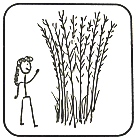 Giant Landscaping Ornamentals |
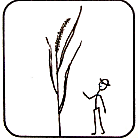 Riparian Grasses such as Reeds |
Visit the Category: Giant Grasses
Tiny Grasses Not Over 8 Inches High
Bear in mind that any grass can be tiny if it is young or located in difficult or extreme growing conditions. But for this category, grasses are always tiny, often only 2 to 4 inches high.
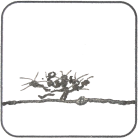 Tiny Messy Grass |
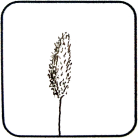 Grasses under 1 Foot Tall |
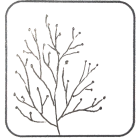 Tiny Mist over the Ground |
Visit the Category: Tiny Grasses
Spiked Grasses that Look Like Wheat
All the wheat-like grasses are true spikes: their "seeds"
(spikelets) attach directly to the seedhead's "stem" or rachis. Spikes have no
branches, and having spikes helps in identification. However, some seedheads have branches that are appressed to the stem,
so they look like spikes. These are called "spike-like". To determine if it is a
spike, fiddle with the seedhead to see if the spikelets are directly attached
to the axis ("rachis"). If not, even
if it looks like a spike, it isn't a true spike but a spike-like grass, and therefore not
in this wheat-like category.
The cereal-crop grasses are in the tribe Triticeae. These include wheat, barley, rye, and others. All of these
look more or less like wheat.
Here are drawings of wheat-like true spikes:
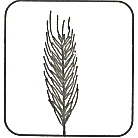 Long-Awned Wheat-like Spike |
 Short-awned Wheat-Like Spike |
Visit the Category: Wheat-like Spiked Grasses
Spikes and Spike-like Grasses that Don't Look Like Wheat
Here are non-wheats:
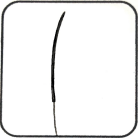 Long Spike |
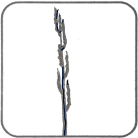 Spike-like |
Visit Spiked and Spike-like Grasses that Don't Look Like Wheat
Puffs
I call it a puff if it looks puffy, like cotton candy or a Q-tip. The spikelets ("seeds") are so fluffy and tiny that you usually cannot tell whether it is a spike or not. So just call it a Puff. Sometimes puffs look spiny, but they might still feel soft. Here are drawings:
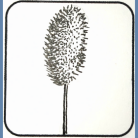 Fat Puff |
 Cylindrical Puff |
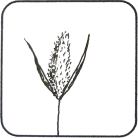 Leaf-based Puff |
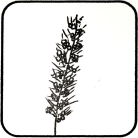 Millet Puff |
Visit the Puffy Grasses
Fingers
Some grasses have slender "fingers" near the top that stand apart or easily pull apart. You can tell that there are narrow branches rather than condensed puffs. I call these Fingers (or Palm Trees) instead of Puffs, and the seedheads are actually branched panicles. Fingers arise near the stem top, while palms arise right at stem top. Here are fingers and a palm:
 Wide Fingers |
 Puffy Fingers |
 Fingers Arise Below Stem Top |
 Palm: Fingers at Stem Top |
Visit the Finger Grasses
Dots on Threads
Some open panicles have just a few small seeds (spikelets) on long partly-bare branches. I call these "Dots on Threads." Here is a drawing of typical "dots on threads:"
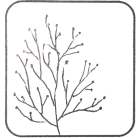 Dots on Threads |
Visit the Dots on Threads
Tiny Spearheads
Some open panicles, the Lovegrasses, have tiny spikelets that often look like spearheads. I separate these from the "Dots on Threads." Here is a drawing of a Lovegrass with its possibly-confusing tiny spearheads:
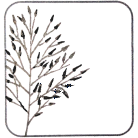 Tiny Spearheads |
Visit the Lovegrasses
Millet-like Grasses with Clustered Round or Oval Spikelets
Here are drawings:
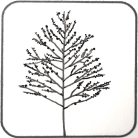 Round Millet Seeds |
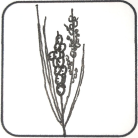 Bunched Seeds |
Visit Millet-like Grasses with Clustered Round or Oval Spikelets
Drooping Grasses
Here is a drawing:
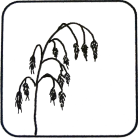 Large Drooping Spikelets |
Visit Drooping Grasses
Awned Panicles and Unawned Panicles
Panicled grasses are by far the most common and the most varied. Remember that a panicle is any grass that is not a spike, even if it looks spike-like. Similar shapes may be awned or unawned. Many grasses (Junegrass for example) start out spike-like when young but open up to panicles when mature.
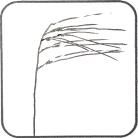 Six-inch Awns |
 Triple Awns |
 Bent Awns |
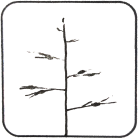 Stiff Branches |
 Upright Branches |
Visit the Awned Panicles
Visit the Unawned Panicles